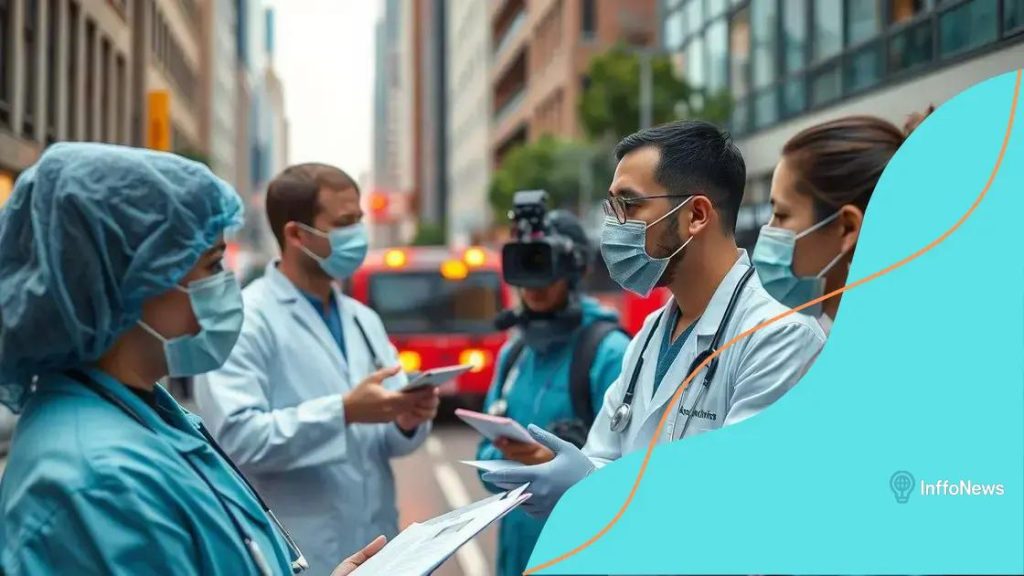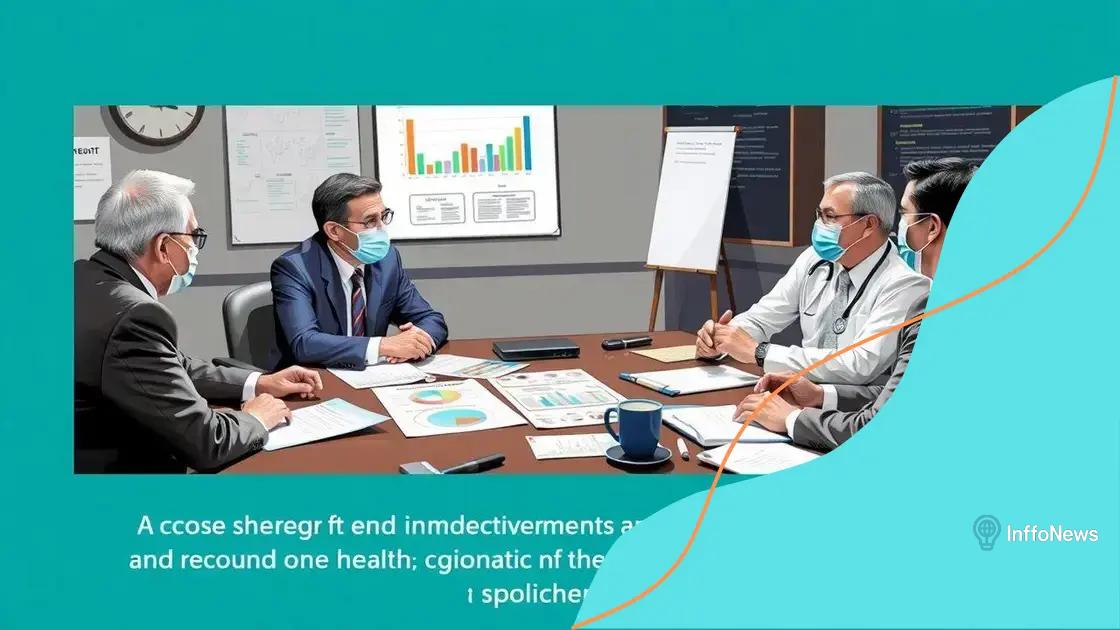Public health emergency response strategies for effective outcomes

Anúncios
Public health emergency response strategies are critical for managing health crises effectively, emphasizing community engagement, resource coordination, and continuous evaluation to enhance future response efforts.
Public health emergency response strategies are crucial for tackling unforeseen health crises. Have you ever wondered how communities manage such high-stakes situations? Let’s delve into these strategies that keep us safe.
Anúncios
Understanding public health emergency response
To grasp the importance of public health emergency response, we first need to recognize its role in safeguarding communities during health crises. These responses are critical for managing outbreaks and ensuring public safety.
What is a Public Health Emergency Response?
A public health emergency response refers to the organized efforts that health departments and organizations undertake during a health crisis. This can include actions like disease surveillance, resource allocation, and communication strategies.
Key Components of an Effective Response
- Rapid Assessment: Quickly evaluating the situation helps determine the necessary actions.
- Communication: Clear messaging to the public is vital for keeping communities informed.
- Coordination: Collaboration among different agencies ensures resources are used efficiently.
- Surveillance: Monitoring health trends aids in identifying and responding to outbreaks.
Each element is essential for ensuring that the response is swift and effective. When these components work in harmony, the chances of controlling an outbreak significantly increase.
Anúncios
Continual training and preparedness enable organizations to adjust their responses as situations evolve. Regular drills and updated plans based on past experiences enhance the effectiveness of future responses.
Moreover, community involvement is crucial. Educating the public about emergency procedures and encouraging participation can foster trust and improve the overall response. When communities are prepared, they can be a vital asset in the face of emergencies.
Key elements of an effective response strategy
Understanding the key elements of an effective response strategy is vital for public health. These elements not only guide actions during crises but also ensure that communities are prepared for any situation.
Planning and Preparedness
Successful strategies begin with thorough planning. This involves assessing potential risks and outlining a clear plan of action. Preparedness ensures that resources are readily available when needed, minimizing delays.
Resource Allocation
Efficient resource allocation is crucial. This means not only having enough supplies but also ensuring they are in the right place at the right time. Key resources include medical personnel, vaccines, and information technology systems.
- Human Resources: Well-trained staff who are ready to respond can make a significant difference.
- Medical Supplies: Stockpiling essentials like medications and protective gear is standard practice.
- Technology: Using technology for communication can facilitate rapid response.
It’s vital to regularly update and train personnel on new protocols. Continuous education ensures everyone understands their roles during a crisis.
Another important element is effective communication. Keeping everyone informed helps to dispel fears and confusion. During a health emergency, clear messaging from health officials can lead to better compliance with guidelines and recommendations.
Collaboration among agencies is essential. Sharing information and resources fosters a united front against health threats. When all stakeholders come together, the response becomes more robust and effective.
Roles of government and organizations in crises

The roles of government and organizations in crises are pivotal for an effective public health response. These entities must work together to ensure that communities receive the help they need.
Government Responsibilities
Governments have a primary role in crisis management. They are responsible for crafting policies and mobilizing resources swiftly. By establishing protocols for emergency response, they provide a clear framework for action.
Coordination with Organizations
Effective communication and coordination with health organizations are essential during a crisis. Governments must liaise with local, national, and international health bodies to ensure the response is unified. Collaborative action prevents overlaps and gaps in service delivery.
- Information Sharing: Governments must share timely data with organizations to inform public health measures.
- Resource Distribution: Efficiently allocating medical supplies and personnel is crucial for timely intervention.
- Public Health Campaigns: Governments should support campaigns that educate the public on safety and health practices.
During crises, organizations such as hospitals, NGOs, and community health groups play critical roles beyond governmental support. They often lead grassroots responses, reaching vulnerable populations more effectively.
Non-governmental organizations (NGOs) are often on the front lines of health emergencies. They provide critical services, resources, and support to affected communities. Their flexibility allows them to respond quickly to the needs of those most impacted.
Partnerships between the government and organizations create a strong framework for addressing public health crises. When both sides collaborate, they enhance the community’s resilience against potential threats.
Community engagement during health emergencies
Community engagement during health emergencies is crucial for an effective response. It empowers individuals and helps officials address public concerns efficiently.
The Importance of Engagement
Engaging the community ensures that everyone is informed and prepared. People who understand the risks can take appropriate measures to protect themselves and others. This collaboration fosters trust and support for health initiatives.
Methods of Community Engagement
- Public Meetings: Hosting local meetings allows officials to share information and listen to community concerns.
- Social Media Campaigns: Using platforms like Facebook and Twitter helps spread information quickly and effectively.
- Partnerships with Local Organizations: Collaborating with schools, churches, and NGOs increases outreach and credibility.
Communication should be clear and accessible, using simple language to reach everyone. Updates should include vital information on health guidelines and resources available in the community.
Furthermore, recognizing and addressing cultural differences enhances community trust. Tailoring messages to reflect community values can lead to greater participation and adherence to health directives.
Involving community leaders in planning and response can also boost engagement. When local representatives advocate for health measures, residents are more likely to participate.
Finally, feedback from the community is essential. Surveys and follow-up meetings can help officials gauge public understanding and concerns, allowing them to adjust their strategies accordingly.
Evaluating response effectiveness post-emergency
Evaluating response effectiveness post-emergency is crucial for improving future strategies. This process involves assessing how well the response managed the emergency and identifying areas for improvement.
Key Evaluation Factors
Evaluations typically focus on several key factors. These include the timeliness of the response, resource management, and community engagement. Each aspect provides insight into what worked and what didn’t during the emergency.
Data Collection Methods
- Surveys: Collecting feedback from community members can reveal how they perceived the response.
- Interviews: Speaking with responders and officials helps gauge their experiences and challenges faced.
- Data Analysis: Reviewing statistics related to health outcomes can show the effectiveness of interventions.
Analyzing this information uncovers patterns that can inform future planning. For example, if surveys indicate confusion about safety protocols, agencies can improve their communication strategies next time.
Moreover, sharing lessons learned with all stakeholders improves collaborative efforts for future emergencies. Creating detailed reports on the evaluation process is crucial for transparency and accountability.
Finally, evaluating the response effectiveness can lead to enhanced training for responders. Continuous learning ensures the team is better prepared for future events.
FAQ – Frequently Asked Questions about Public Health Emergency Response
Why is community engagement important during health emergencies?
Community engagement ensures that the public is informed, prepared, and motivated to participate in health initiatives, improving overall response effectiveness.
What role do government and organizations play in responding to health emergencies?
Governments draft policies and coordinate resources, while organizations provide frontline support and local engagement to ensure a comprehensive response.
How can response effectiveness be evaluated after an emergency?
Response effectiveness can be evaluated through surveys, interviews, and data analysis to identify successes and areas for improvement.
What are some key elements of an effective public health response strategy?
Key elements include preparedness planning, resource allocation, effective communication, and collaboration among various stakeholders.





